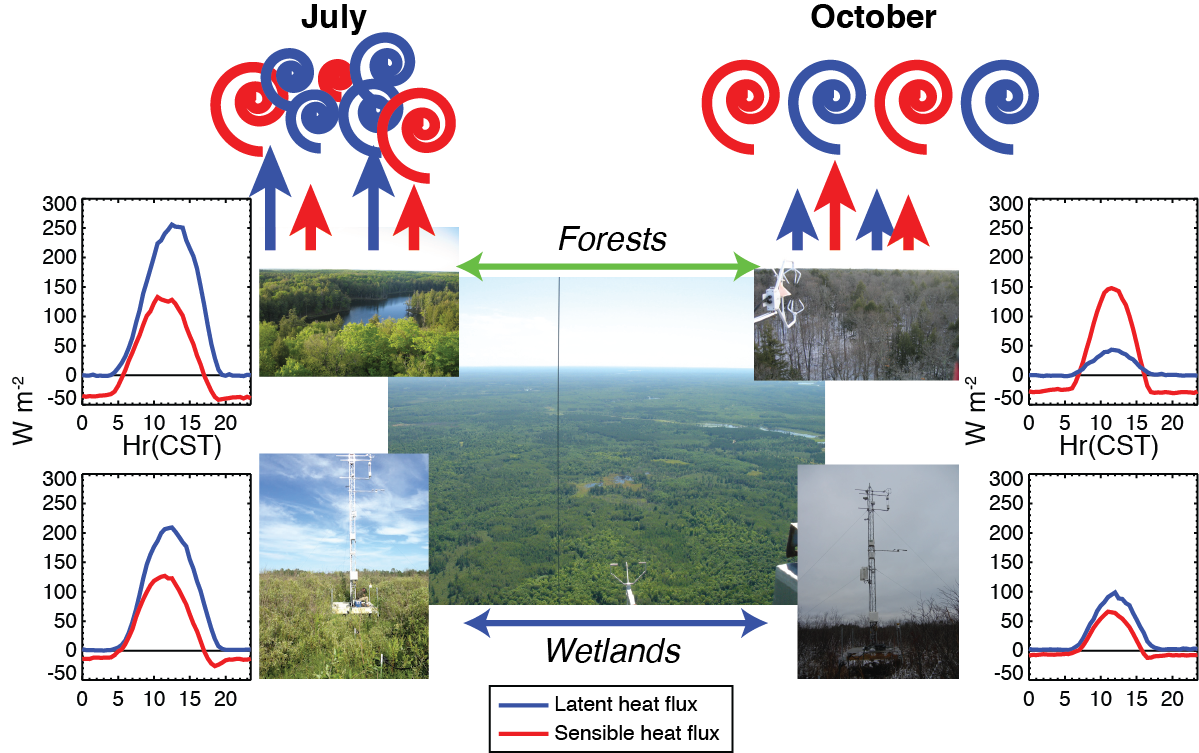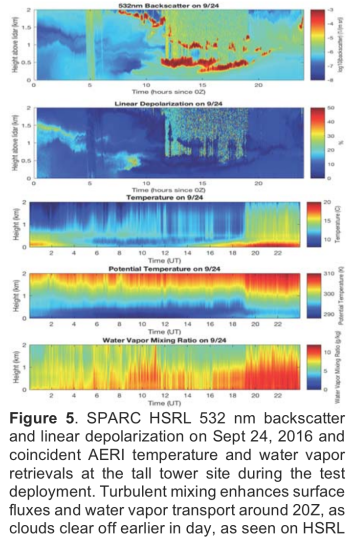CHEESEHEAD19
CHEESEHEAD19 tower sites - get these data at: http://cheesehead19.org
CHEESEHEAD19 is an intensive field-campaign designed specifically to address long-standing puzzles regarding the role of atmospheric boundary-layer responses to scales of spatial heterogeneity in surface-atmosphere heat and water exchanges.
PRINCIPAL INVESTIGATORS
Ankur R Desai
Stefan Metzger (Battelle Ecology)
Grant Petty
Phil Townsend (Forest and Wildlife Ecology)
Mark Schwartz (UW-Milwaukee)
Rose Pertzborn (SSEC)
Staff
Jonathan Thom (SSEC)
Rose Pertzborn (SSEC)
Brian Butterworth (UW-Madison)
Ke Xu (U Michigan)
Ryan Clare (UW-Madison)
Sreenath Paleri (UW-Madison)
Bailey Murphy (UW-Madison)
James Mineau (UW-Madison)
Leo Mikula (UW-Madison)
Full list at here
Overview
The living biosphere interacts with atmospheric processes at a multitude of scales. Understanding these processes requires integration of multiple observations for comparison to theories embedded in atmospheric models. But, all observations mismatch the scale of all models. Therefore, spatial and temporal scaling of surface fluxes is fundamental to how we evaluate theories on what happens within the sub-grid of atmospheric models and how those feed back onto larger scale dynamics. The Chequamegon Heterogeneous Ecosystem Energy-balance Study Enabled by a High-density Extensive Array of Detectors (CHEESEHEAD) is an intensive field-campaign designed specifically to address long-standing puzzles regarding the role of atmospheric boundary-layer responses to scales of spatial heterogeneity in surface-atmosphere heat and water exchanges.
Intellectual Merit
The high-density observing network is coupled to large eddy simulation (LES) and machine-learning scaling-experiments to better understand sub-mesoscale responses and improve numerical weather and climate prediction formulations of sub-grid processes. This project will advance spatiotemporal scaling methods for heterogeneous land surface properties and fluxes and theories on the scales at which the lower atmosphere responds to surface heterogeneity. CHEESEHEAD aims to provide a level of observation density and instrumentation reliability never previously achieved to test and develop hypotheses on spatial heterogeneity and atmosphere feedbacks.
Broader Impacts
The experiment generates knowledge that advances the science of surface flux measurement and modeling, relevant to many scientific applications such as numerical weather prediction, climate change, energy resources, and computational fluid dynamics. The research will train next generation land-atmosphere graduate and undergraduate students. Field support outreach and teacher training is included via middle, high school, and undergraduate student involvement at nearby schools and colleges in coordination with UCAR's (University Corporation for Atmospheric Research) GLOBE program, Northland College, and local school districts. The database of observations and models will be made immediately available to the community and public for general use for further scientific advancement.
Instrument, Education and Site Leads
SPARC (SSEC): Tim Wagner, Erik Olson, Wayne Feltz
University of Wyoming King Air: Al Rodi, Zhien Wang
UW Ultralight: Grant Petty (UW-Madison)
UW Spectral Explorer: Phil Townsend (UW-Madison)
NCAR Instrumented Surface Flux Facilities: Steve Oncley (NCAR)
NCAR Integrated Sounding System: Bill Brown (NCAR)
KIT IMK-IFU Wind Lidar and LES development: Matthias Mauder (KIT)
NEON Mobile Deployment Platform, Ameriflux mobile systems
Field support: Linda Parker (USFS), Scott Bowe (Kemp Natural Resources Station)
Existing tall tower partners: Arlyn Andrews/Jon Kofler (NOAA GHG, flasks, airborne profiles), Paul Wennberg/Gretchen Keppel-Aleks (TCCON), Marek Zreda (COSMOS)
Education/outreach: Rose Pertzborn (SSEC/GLOBE), Jon Martin (Northland College), Mike Notaro (CCR), April Hiscox (U South Carolina), Butternut, WI school district, CLASS ACT charter school (Park Falls, WI)
Selected PUBLICATIONS
Desai, A.R., Paleri, S., Mineau, K., Kadum, H., Wanner, L., Mauder, M., Butterworth, B.J., Durden, D., Metzger, S., 2022. Scaling land-atmosphere interactions: Special or fundamental? J Geophys. Res. - Biogeosciences, 127, e2022JG007097, doi:10.1029/2022JG007097.
Paleri, S., Desai, A.R., Metzger, S., Durden, D., Butterworth, B.J., Mauder, M., Kohneret, K., Serafimovich, A., 2022. Space - scale resolved surface-atmospheric fluxes across a heterogeneous mid-latitude forested landscape. J Geophys Res: Atmospheres, 127, e2022JD037138, doi:10.1029/2022JD037138
Murphy, B., May, J., Butterworth, B., Andresen, C., Desai, A.R., 2022. Unravelling Forest Complexity: Resource Use Efficiency, Disturbance, and the Structure-Function Relationship. Journal of Geophysical Research: Biogeosciences, 127, e2021JG006748, doi:10.1029/2021JG006748
Butterworth, B.J., Desai, A.R., Metzger, S., Townsend, P.A., Schwartz, M.D., Petty, G.W., Mauder, M., Vogelmann, H., Andresen, C.G., Augustine, T.J., Bertram, T.H., Brown, W.O.J., Buban, M., Cleary, P., Durden, D.J., Florian, C.R., Ruiz, E.G., Iglinski, T.J., Kruger, E.L., Lantz, K., Lee, T.R., Meyers, T.P., Mineau, J.K., Olson, E.R., Oncley, S.P., Paleri, S., Pertzborn, R.A., Pettersen, C., Plummer , D.M., Riihimaki, L., Sedlar, J., Smith, E.N., Speidel, J., Stoy, P.C., Sühring, M., Thom, J.E., Turner, D.D., Vermeuel, M.P., Wagner, T.J., Wang, Z., Wanner, L., White, L.D., Wilczak, J.M.M., Wright, D.B., and Zheng, T., 2021. Connecting Land-Atmosphere Interactions to Surface Heterogeneity in CHEESEHEAD19, Bulletin of the American Meteorological Society, 102(2), E421-E445, doi:10.1175/BAMS-D-19-0346.1.
Desai, A.R., Khan, A.M., Zheng, T., Paleri, S., Butterworth, B., Lee, T.R., Fisher, J.B., Hulley, G., Kleynhans, T., Gerace, A., Townsend, P.A., Stoy, P.C., Metzger, S., 2021. Multi-sensor approach for high space and time resolution land surface temperature, Earth and Space Science, , 8, e2021EA001842, doi:10.1029/2021EA001842.
Vermeuel, M., Cleary, P., Desai, A.R., Bertram, T., 2021. Simultaneous measurements of O3 and HCOOH vertical fluxes indicate that rapid in-canopy terpene chemistry drives O3 deposition in mixed temperate forests. Geophys. Res. Lett., 48, e2020GL090996, doi:10.1029/2020GL090996.
Xu, K., Sühring, M., Metzger, S., Durden,D., Desai, A.R., 2020. Can data mining help eddy-covariance see the landscape? A large-eddy simulation study, Boundary-Layer Meteorology, 176, 85-103, doi:10.1007/s10546-020-00513-0. (link)
Sühring, M., Metzger, S., Xu, K., and Desai, A.R., 2019. Tradeoffs in flux dis-aggregation: a large-eddy simulation study. Boundary Layer Meteorology, 170, 69–93, doi:10.1007/s10546-018-0387-x.
Xu, K., Metzger, S., Desai, A.R., 2018 Surface-atmosphere exchange in a box: Space-time resolved storage and net vertical fluxes from tower-based eddy covariance. Agricultural and Forest Meteorology, 255, 81-91, doi:10.1016/j.agrformet.2017.10.011. (link) (companion from Metzger et al)
Xu, K., Metzger, S., Desai, A.R., 2017. Upscaling tower-observed turbulent exchange at fine spatio- temporal resolution using environmental response functions. Agricultural and Forest Meteorology, 232:10-22, doi:10.1016/j.agrformet.2016.07.019. (link)
Project news & events
Project gallery
Award Abstract #1822420
$1,610,000
2018-2021
Key links
Google group (primary listserv)
Media Coverage
NOAA ATDD UAS article (August 2019)
CHEESEHEAD open house (August 2019)
Price County Review (May 2019)
UW News (July 2018)
Follow up coverage at BTN Wisconsin Gazette Public News Service Wisconsin State Farmer
Positions
Interested students who want to do a Ph.D., undergraduate internship, or post-doc, please contact Ankur.
presentations
The Great Coupling: Advancing boundary-layer research at flux tower observatories and experiments
NOAA eGMAC Webinar: Planetary Boundary Layers, Boulder, CO, June 29, 2020 (invited)
Energetic Ecosystems Emit Enchanting Emissions
(REMOTE)University of Illinois, Urbana-Champaign, IL, NRES Seminar, March 27, 2020 (invited)
Partnerships for Science: Wisconsin ECB and UW-Madison, Two Decades of Innovation at the WLEF-TV Park Falls Tall Tower
Board of Wisconsin Educational Communications Board, Madison, WI, Jan 31, 2020 (invited)
Can satellite greenhouse gas remote sensing capture regional spatial variability in fluxes, drivers, and atmospheric response?
American Geophysical Union Fall Meeting, San Francisco, CA, Dec 9-13, 2019 (invited)
Inland water bodies as surface energy hotspots
American Geophysical Union Fall Meeting, San Francisco, CA, Dec 9-13, 2019 (invited)
Twenty-nine towers, twenty-nine stories: The ChEAS core site cluster journey
Ameriflux Community Meeting, Boulder, CO, Sept 18, 2019
A CHEESEHEAD of Scientists?
Park Falls Public Library, Park Falls, WI, May 21, 2019
Advancing the science of Earth energy and carbon exchanges
Carnegie Institute of Washington Global Ecology, Stanford University, Palo Alto, CA, Mar 19, 2019 (invited)
Don’t we have enough flux towers already?
Land, Atmoshere, Water Research Seminar, UC-Davis, Davis, CA, Oct 25, 2017
How many flux towers are enough? Energy balance closure and large eddy simulation as diagnostic tools for secondary circulations
AMS 22nd Meeting on Boundary Layers and Turbulence, Salt Lake City, UT, Jun 21, 2016












